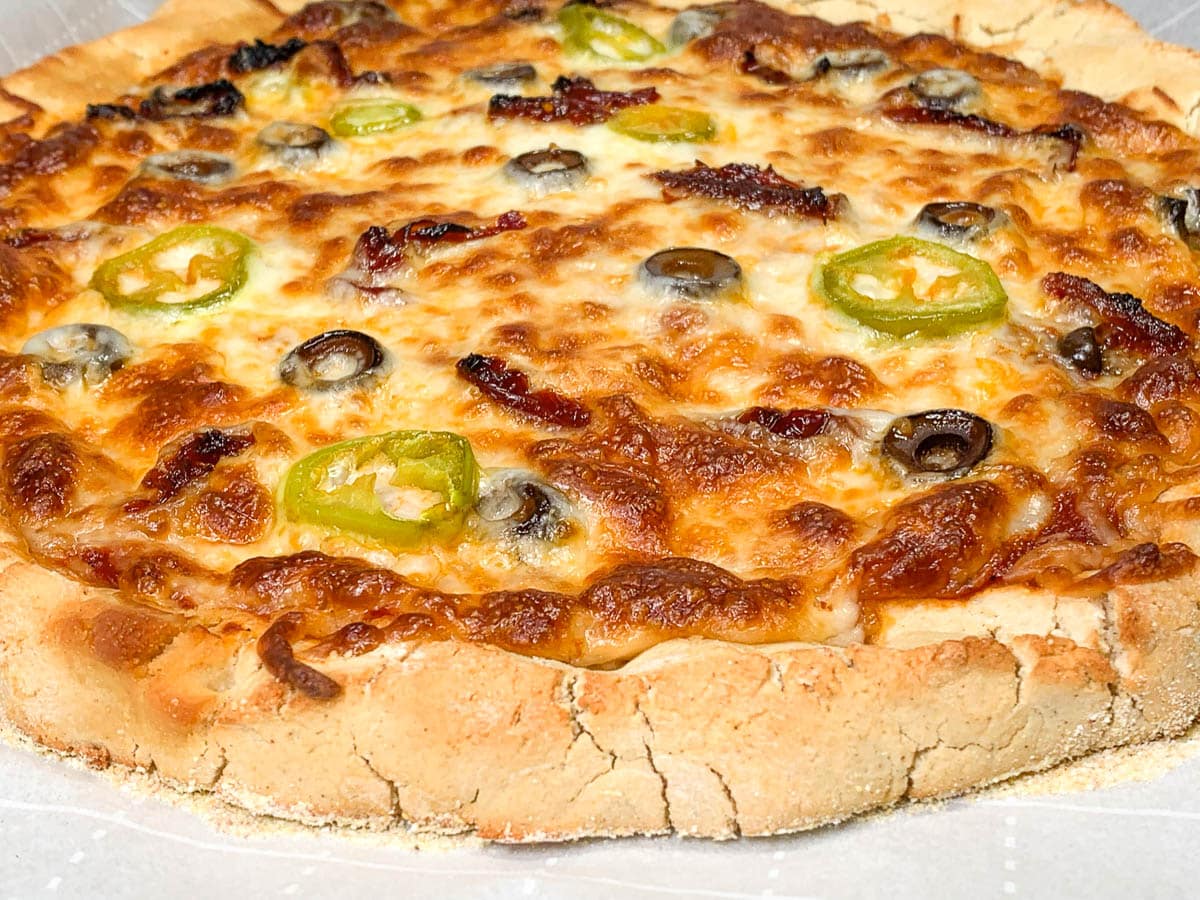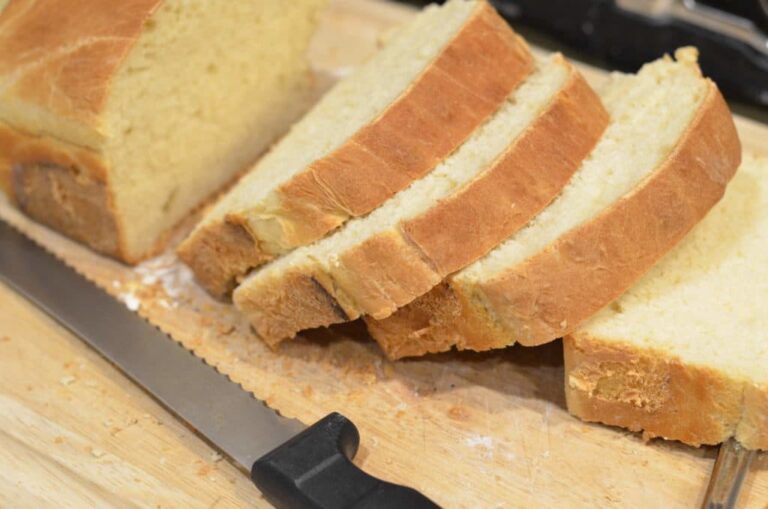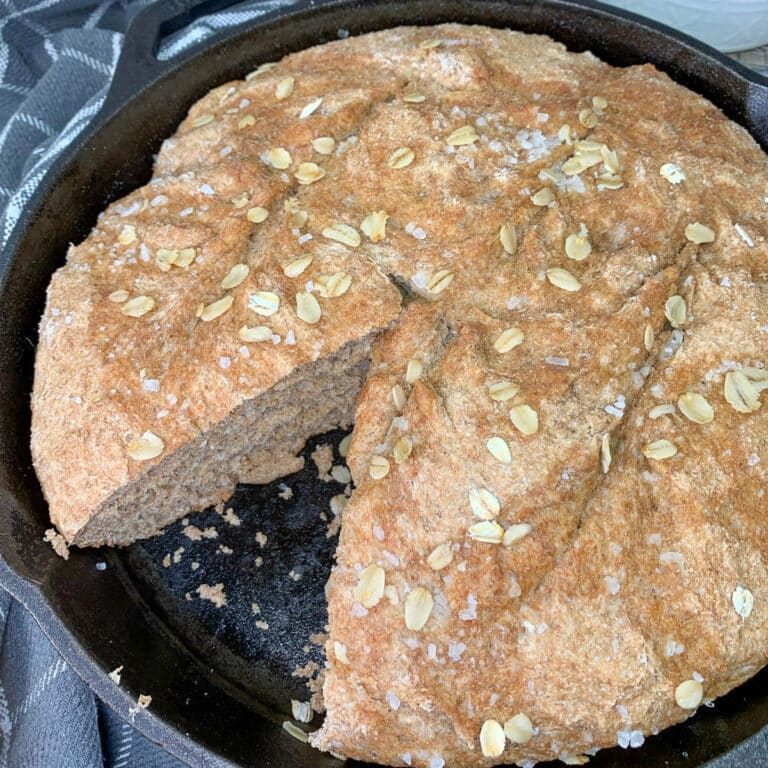
There’s nothing like homemade pizza. I like to make my own pizza dough and decided to try a gluten-free version this time around as a healthier alternative to the pizza dough I usually make.

The process for making gluten-free pizza dough is not much different than making regular pizza dough. I do suggest that you try to buy quality gluten-free baking flour to ensure the best results possible. Brands like Bob’s Red Mill, King Arthur or Krusteaz.
My Latest Videos

Ingredient Substitution
Unless you bake often, you might not have any Xantham Gum on hand. If you don’t and don’t want to buy any you can simply substitute for an equal amount of Cornstarch, which will be 2 1/2 teaspoons for this pizza dough recipe.

If you are feeling ambitious, you can also make your very own homemade pizza sauce to go with this homemade pizza dough by checking out my Easy Homemade Pizza Sauce recipe. The perfect pizza sauce to go with this delicious pizza dough.

Instant Yeast vs Active Dry Yeast
Instant Yeast Does not need to be dissolved in water before use and can be mixed directly into the dry ingredients. On the other hand, Active Dry Yeast has to be dissolved in warm water with a bit of sugar before use to ensure it’s alive.
Does Yeast Go Bad?
Active Dry Yeast can go bad since it’s a living organism. It typically has a shelf life of 1–2 years when stored properly. To check if your yeast is still active, dissolve 1 teaspoon of sugar in ¼ cup of warm water. Add 1 packet of active dry yeast, stir, and wait for 5–10 minutes. If the mixture becomes frothy and bubbly, the yeast is still good. If not, it’s time to replace it.
Instant Yeast has a longer shelf life than active dry yeast but can still go bad. To test it, Dissolve ½ teaspoon of sugar in ¼ cup of warm water. Stir in 1 teaspoon of instant yeast. Wait 5-10 minutes. If the mixture foams and bubbles, the yeast is still active. If nothing happens, it’s time to replace it.
What is Xanthan Gum
Not familiar with Xanthan Gum? It’s typically used when making gluten free baked goods. Xanthan Gum helps your baked goods hold together instead of turning crumbly. Xanthan Gum is also believed to be healthier than Cornstarch as the latter contains a lot of carbs and calories.

What is Rising & Proofing
Rising is the process where carbon dioxide makes the dough rise and develop flavor. Put the dough in a lightly oiled bowl (olive oil or non-stick spray) and cover with a tea towel or plastic wrap. The dough should be left in a warm location until it has doubled in size.
Proofing basically means the last rise of the dough in its final shape (e.g. bun, loaf, etc.) before baking. Many factors come into play for how long it will take to prove the dough. You can tell when the dough is ready for baking when the dough springs back after you gently press the dough with your finger.

Tips
- I strongly recommend you use a kitchen scale to measure out the gluten-free baking flour. Using measuring cups may not give you the desired results due to the density of the flour.
- Ideally the water should be between 105°F-110°F before adding the yeast. Water above 120°F will kill the yeast.

Our Favorite Pizza Gadgets
 Buy Now →
Buy Now →  Buy Now →
Buy Now →  Buy Now →
Buy Now →  Buy Now →
Buy Now →  Buy Now →
Buy Now →  Buy Now →
Buy Now → Gather your Ingredients
You will need the following ingredients to make this Gluten Free Pizza Dough recipe (see recipe card for quantities): Warm Water, Active Dry Yeast, White Sugar, Gluten Free Baking Flour, Xanthan Gum, Salt, Baking Powder and Cornmeal.
How to Make Gluten-Free Pizza Dough
- In a small bowl, combine the warm water, yeast and white sugar. Set aside and let sit for at least 5 minutes.
- In your stand mixer, combine the gluten-free flour, xanthan gum, salt, and baking powder.
- Once the yeast has started to foam, add it to the flour mixture and using a dough hook, mix until the dough is soft and sticky. Cover the bowl with wrap and let sit until the dough has doubled in size, approximately 1 1/2 to 2 hours.
- When the dough is ready for baking, preheat the oven to 450°F.
- Line a baking sheet with parchment paper. Lightly sprinkle with cornmeal. Shape the dough to the desired shape and size. Place the dough on the baking sheet. Add your favorite toppings.
- Bake for 20-25 minutes or until the crust is done.
More Recipe Ideas

Gluten Free Pizza Dough
↑ Click stars to rate
Ingredients
- 1 Cup Warm Water, 105°F-110°F
- 2 Tsp Active Dry Yeast
- 2 Tsp White Sugar
- 204 Grams Gluten-Free Baking Flour
- 2 ½ Tsp Xanthan Gum
- 1 Tsp Salt
- ½ Tsp Baking Powder
- Yellow Cornmeal, for sprinkling
Instructions
- In a small bowl, combine the warm water, yeast and white sugar. Set aside and let sit for at least 5 minutes.
- In your stand mixer, combine the gluten free flour, xanthan gum, salt and baking powder.
- Once the yeast has started to foam, add it to the flour mixture and using a dough hook, mix until the dough is soft and sticky. Cover the bowl with wrap and let sit until the dough has doubled in size, approximately 1 1/2 to 2 hours.
- When the dough is ready for baking, preheat the oven to 450°F.
- Line a baking sheet with parchment paper. Lightly sprinkle with cornmeal. Shape the dough to the desired shape and size. Place the dough on the baking sheet. Add your favorite toppings.
- Bake for 20-25 minutes or until the crust is done.





This was the first gluten free pizza crust I had ever made. Very easy to make. The longest part was waiting for the dough to rise. But after that it was a breeze. The pizza was delicious. Will continue to make this crust.